It was a new novel, the third in her latest series, and, as always, in the early stages of the process the seasoned author required a new notepad for jotting down ideas, thoughts, and research notes. So she flipped back the blue cardboard cover to reveal the first page of the freshly-purchased spiral notebook.
A different color notepad for each book. The last one, red, for Nothing Could Be Finer Than a Murder in Carolina, and the one before it was green for her bestseller Strawberry Fiends Forever. This one, the blue one … Blood on the Beach.
Six new #2 pencils lay on her desk. Beside them was a pencil sharpener made to look like an elephant. To sharpen a pencil one simply inserted it into the elephant’s rear end, then crank the trunk to set in motion the internal bits and bobs that ground away the parts of the pencil that prevented its end from being pointy.
She stared at the blank page for a moment while various settings and scenes came to life on her internal movie screen. Characters, some old and some new, began to breathe, smile, and walk and talk. They moved slowly at first, as if they’d just received their first sets of arms and legs. They were as unsure of their footing as they were of why they were where they were and how they’d gotten there.
It wasn’t long, though, before heroes and villains and secondary make-belive folks picked up speed until they were doing clever, cunning, charactery things that could potentially send them toward their final desination, a page called “The End.”
The crafty writer, a devout plotter, sketched out a rough timeline, working in reverse from the discovery of the body. Everything looked wonderful and she was well on her way and she was excited because this one felt so, so right. Yes, this one just might finally earn her an Edgar Award. First, though, she needed an ingenious cause of death.
Shootings were overdone, done to death, actually. Bludgeonings are boring. Stabbings are always far too up close and personal. And they’re messy. Cut brake lines are predictable and cliche’.
But a good poisoning, if done correctly, can lead a reader down a tight and sometimes terrifing, twisty plot that’ll keep them turning pages well into the night.
Toxins, the good ones, are reliable, and they’re hard to detect at autopsy, if the killer is careful about hiding evidence. Yes, this one would be a good, old-fashioned poisoning.
It was time to begin her favorite part of writing … research.
Poison as the Weapon of Choice in a Fictional Murder
Writers of various genres often spend countless hours devising clever and hopefully undetectable ways of sending murder victims to their graves. One such favored instrument of death, poisoning, has proven quite reliable on the written page.
To help with your research, below are a few deadly toxins that thrive naturally. So they’re “easy pickins’ for the villains in your stories.
Remember, though, that these fatal floras are available and ready for picking not just by fictional characters, but by anyone, even your spouses, partners, coworkers, and friends and/or enemies. Some of these plants could even be found in backyards or beside favorite hiking trails.
So, if you’ve had a few rocky days of at-the-top-of-the-lungs, dish-throwing arguing after doing and saying some of the dumbest, most insensitive things you could possibly say and do, perhaps you should be on high-alert if the better-half suddenly decided to spend an afternoon in the woods foraging for healthy wild greens and mushrooms. Sure, she said she wantd to keep you young and in good physical condition by preparing better heart-healthy meal choices, but revenge for things said and done that you can never take back could come in the form of a side dish that includes a portion of chopped belladonna, or hemlock.
The Poisons
Belladonna, often called nightshade, is a popular ornamental plant. It’s name means “beautiful woman” in Italian. A single six or seven drop dose derived from the plant’s toxic parts (roots, leaves, and berries) can cause death within a few hours. Victims could also suffer miserably for a few days before succumbing to the plant.
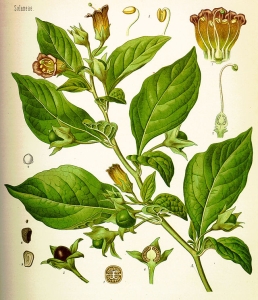
Symptoms include increased heart rate, rapid pulse and respiration, fever, convulsions, and coma. Some have said belladonna poisoning even causes a loud heartbeat that can be heard from several feet away.
Belladonna is also known as Belle-Dame, Belle-Galante, Bouton Noir, Deadly Nightshade, Devil’s Cherries, Devil’s Herb, Dwale, Dwayberry, Grande Morelle, Guigne de la Côte, Herbe à la Mort, Herbe du Diable, Naughty Man’s Cherries, and Poison Black Cherries, and more.
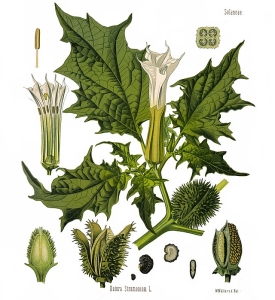
In 1676, in Jamestown, Va., a potion was concocted to help relieve the distress of soldiers involved in the Bacon Rebellion. One of the potion’s ingredients was a readily available wild plant typically used by the settlers to make salves for treating burns.
Soon after ingesting the newly formulated distress-relieving remedy, the soldiers developed unexpected hallucinations and other peculiar behavior. The wicked weed, originally known as Jamestown weed, is now known as Jimsonweed (Datura stramonium).
Jimsonweed is a potentially deadly plant that’s sometimes abused as a hallucinogen. All parts of the plant are poisonous, but the leaves and seeds contain the high concentrations of atropine, hyoscyamine, and scopolamine.
Street Names for Jimson Weed: Thornapple, stinkweed, locoweed, augushka, ditch weed, devil’s snare, devil’s seed, devil’s trumpet, Korean morning glory, Jamestown weed, angel’s trumpet, beelzebub’s twinkie, madhatter, and crazy tea ~ DEA
A single jimson weed seed pod can contain as many as 100 individual seeds. One hundred jimson weed seeds contain approximately 6 mg of atropine. A dose of atropine exceeding 10 mg is regarded as potentially lethal.
Ingestion of jimson weed produces the toxidrome—a group of symptoms associated with exposure to a particular poison—of anticholinergic intoxication. The classic signs and symptoms of anticholinergic intoxication include “dry, flushed skin; hallucinations; agitation; hyperthermia; urinary retention; delayed intestinal motility; tachycardia; and episodes of seizure. The mnemonic for anticholinergic symptoms—“’blind as a bat, dry as a bone, red as a beet, mad as a hatter, and hot as a hare.'” ~ National Library of Medicine.
Prison inmates working on roadside cleanup crews often harvest the plant’s tiny black seeds that, when consumed, produce the unusual high that’s associated with this prickly plant.
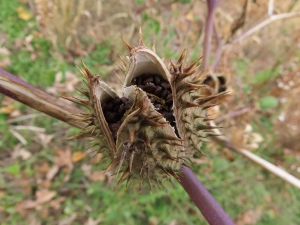
Jimsonweed seed pods contain as many as 100 tiny, black seeds
For example …
Once, while working as a corrections officer inside a maximum security facility, I overheard a young inmate called Short Timmy who was severely straining his vocal chords while loudly imitating the sounds of a motorcycle engine. And, amid the vrooms, zooms, growls, roars, and revving and snarling motor noises, were brief chuckles, giggles, and an enthusiastic argument Short Timmy was having with an imaginary biker he called Buck.
Buck was, as I later understood, fully-clothed in biker attire, including a helmet. Buck’s imaginary appearance was in sharp contrast to the the very real and absolutely naked Short Timmy. Buck, as explained to me, was quite the acrobat and trick-rider.

Obviously, one of the major side effects of Jimsonweed consumption is delirium, and Short Timmy’s hallucinations were working overtime as I rounded the corner of the open-stalled bathroom area where he sat on a toilet wearing nothing but curly, shoulder-length greasy hair and neck-to-toe jailhouse tattoos, front, back, sides, and ALL appendages. Other than that, he was totally nude. He’d also slathered his entire body with a genrous portion of some sort of oil. He smelled like a salad dressing or the beginnings of fried chicken or French fries, so I assumed he’d gotten his hands on cooking oil from the dining hall kitchen.
Short Timmy sat there in all his natural glory, with his bare, heavily pimpled, inked bottom perched atop a big old flush-capable stainless steel “Harley.”
He held his hands as if they were gripping handlebars, throttle, and brake controls, and he was pushing his fictitious bike to its limits. He leaned his body leaned forward over “the handlebars” to reduce wind friction, I supposed, and he did so while laughing like a madman, in short bursts of chimp-like squeals and screeches.
When he saw me his lips split into a tight grin as he wiggled his stubby and grubby fingers in my direction. The gesture was a childlike bye-bye wave aimed at me just before throttling the metal toilet into high gear. He shouted a few words to Buck (above the engine sounds) and he leaned further toward the front tire, crouching low while turning the throttle as far as mechanically possible. I assumed that he and Buck were riding off toward the horizon to avoid capture. They were doing 180 mph, or more. A guess, of course, because I didn’t have a radar unit handy. Not much need for one inside a prison bathroom, you know.
Their high rate of speed didn’t work, though, because the powerful bike was no match for my shiny and black fake leather shoes. Yes, miraculously, I was able to effectively pursue and catch up to the pair—Short Timmy and Imaginary Buck—on foot.
I easily apprehended the desperados and carted both to the medical department. Buck was released and soon disappeared into wherever it is specters live until they’re again needed. Short Timmy, after a brief stay in the infirmary because of his consumption of homemade jimson weed tea, spent a few weeks in “the hole.”
In addition to delirium, other jimsonweed side effects are blurred vision vertigo, blindness, involuntary movements, convulsions, coma, and sometimes death.
*The largest single outbreak of jimson weed poisoning—293 suspected cases—occurred in 2019, in Uganda, where villagers consumed contaminated corn-soy relief food sourced from Turkey, by way of Mombasa, Kenya. Five deaths were reported.
Unintentional Jimson Weed Poisoning in a Family
One evening, a woman prepared a home-cooked soup using ingredients she’d gathered from her own backyard garden. When done, she, her husband, and their daughter sat down to enjoy the meal.
Not long after, a medical response team received a call from the family’s neighbor, who was concerned about the sudden downturn in their physical condition.
The family was rushed to the ER, where they were treated for intense nausea and vomiting, visual disturbances and hallucinations, skin flushing, and peculiar behavior. To add to the concern, the woman was 18 weeks pregnant. During her examination, she was observed reaching out to grab and clutch objects that weren’t there, and she conversed with people who were also not present.
Since the husband consumed a larger portion of the soup, the effects of the poison were far more pronounced in him than in his wife and daughter, and he was treated accordingly, including a stay in ICU. His hospital stay was for seven days, theirs was for less.
*Jimsonweed has a shallow root system and is easily eradicated by hand-weeding, especially as a young plant. Contact with plant parts is of no danger. Broadleaf herbicides such as 2,4-D, a broadleaf weed killer is used to control weeds such as pesky plantain, and to prevent the growth and unwanted spreading of ground cover such as pachysandra, and it provides control of jimson weed.
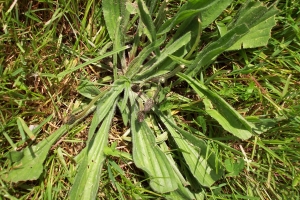
Plantain – weed

Pachysandra terminalis
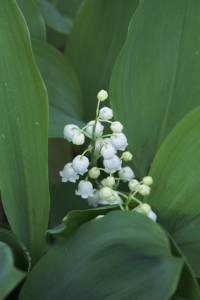 Lilly of the Valley, aka Our Lady’s Tears, is found throughout the United States and Canada. The plants toxicity level is quite high, a level six, and causes an immediate reaction to the unsuspecting victim. Even the water in which the plant’s cut flowers are kept is deadly. Symptoms include, hallucinations, vomiting, clammy skin, hot flashes, coma, and death.
Lilly of the Valley, aka Our Lady’s Tears, is found throughout the United States and Canada. The plants toxicity level is quite high, a level six, and causes an immediate reaction to the unsuspecting victim. Even the water in which the plant’s cut flowers are kept is deadly. Symptoms include, hallucinations, vomiting, clammy skin, hot flashes, coma, and death.

Spotted water hemlock
Hemlock
Finally, for the last poison du jour, we must first journey back in time to 399 BC, when philosopher Socrates was on trial for corrupting the minds of the youth of Athens. In addition, he was charged for for worshipping false gods instead of worshipping the officially recognized gods of Athens.
Not having the benefit of hearing the future what is now referred to as “the old adage that he who represents himself has a fool for a client,” Socrates chose to represent himself during the proceedings. And, as would be expected even in modern times, a jury found him guilty.
Socrates, knowing the penalty for his crimes could be quite serious, jokingly suggested that his punishment be that the state provide him with free food and housing for services he rendered to the city. Of a more serious note, he asked that he be fined his entire net worth, one mina of silver (approximately 1.25 pounds). The jury rejected the philosopher’s offer and sentenced Socrates to death. He was made to drink a cup of deadly hemlock, possibly wine infused with the deadly poison.
Spotted water hemlock can be found growing most of North America. It’s a highly poisonous plant grows along ditches and wet areas throughout most of North America, including on our property.


